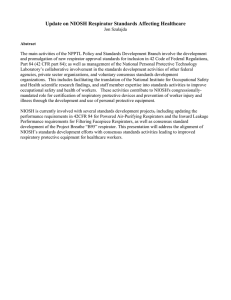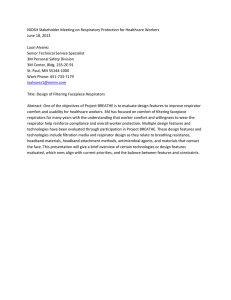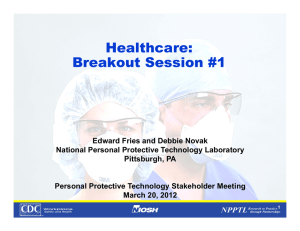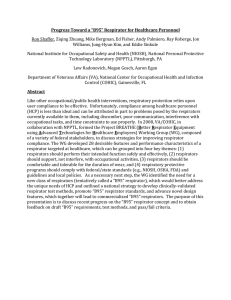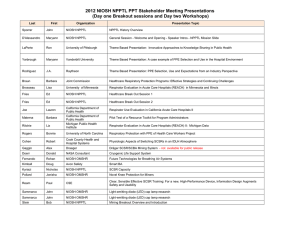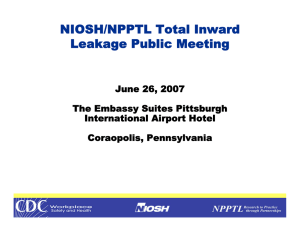Welcome to the NIOSH NPPTL Meeting for All Respirator Manufacturers September 18, 2013
advertisement
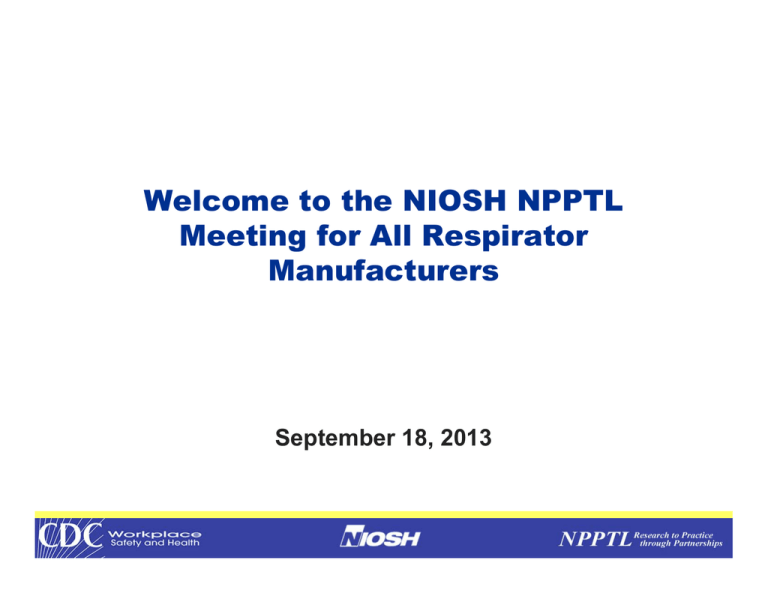
Welcome to the NIOSH NPPTL Meeting for All Respirator Manufacturers September 18, 2013 AGENDA Time Topic 8:30 am – 9:00 am Registration 9:00 am – 9:15 am Welcome, Meeting Activity Reminders 9:15 am – 9:45 am Organization and Introduction of Interim Leadership Team 9:45 am – 11:00 am Standard Application Procedure (SAP), Break 11:00 am – 11:30 am Emergency Breathing Safety Systems (EBSS) 11:30 am – 11:45 am Identification of Devices Used In Research Reports 11:45 am – 12:00 pm Information for Stockpiling Respirators 12:00 pm – 12:45 pm Lunch 12:45 pm – 1:00 pm Policy/Rule Change Notification Methods 1:00 pm – 1:45 pm Breakouts – Brainstorming on Stockpiles and Notification Methods 1:45 pm – 2:30 pm Reports and Discussion 2:30 pm – 3:00 pm Q&A _ Staff availabile for remainder of day Today’s Activity Reminders Rest rooms off the lobby Escorts required for other movement Cash Payment for pre-ordered lunches Restrictions on departing site Surrender Visitor ID Repeat visitor processing for re-entry TEB personnel available for discussions We Want to Know What are we doing well? What could we do better? What should we stop doing? Organization and Introduction of Interim Leadership Team NPPTL Activities Scientific evaluations NPPTL OD Program evaluations Conformity assessment Emergency response Special Projects Technology Evaluation Policy & Standards Development Technology Research Surveillance and Communications Key Drivers for Organization Change use of voluntary consensus standards the need to obtain efficiencies in the utilization of facilities and personnel increasing the integration of post-certification activities, and better understand barriers to PPE use and to develop and implement interventions to improve use compliance Our vision is to continue to be a PPE leader and improve this leadership by most effectively leveraging our laboratory resources, leading respiratory and non-respiratory conformity assessment activities, emphasizing PPE compliance improvement. We Want to Know What are we doing well? What could we do better? What should we stop doing? Application Issues Standard Application Procedure (SAP) Jay A. Parker MS CIH Physical Scientist NIOSH - NPPTL Application Issues Selection of Type of Application New, Extension, QA, Correlation NEW is for complete new approval, or for modifications to existing (approved) respirator(s) that AFFECT PROTECTION Examples: Adding new cartridge or filter to existing facepiece(s), adding new gas to existing cartridge respirator, adding alternate elastic headbands with different elasticity to filtering facepiece respirator, adding new sizes to existing model of FFR Application Issues Selection of Type of Application EXTENSION is for modification(s) to existing approval(s) that do not AFFECT PROTECTION. List all affected TC#s in Reason for Application section, or identify all affected TC#s on the accompanying matrices. One change to multiple approvals or multiple changes to one approval OK on one application Examples: Adding alternate sorbent for chemical cartridge respirator, changing part number(s), private label applications, changing inspection or sampling procedures Application Issues Selection of Type of Application Do not mix request types. Projects that result in modifications to approvals along with new configurations need to be split into (at least) two applications. (At least) One application to request approval for the new respirator configurations, And… (At least) One application to request modification to the existing approval(s) No intent to duplicate required testing One project is likely to be dependent upon the other Application Issues Selection of Type of Application QA is for modification(s) to existing QA manual No assembly matrix required Use EXTENSION instead and include assembly matrix if changes involve Product Quality Plans, sampling plans or inspection procedures, (all affected approvals need to be identified) Application Issues Selection of Type of Application CORRELATION is for correlation testing by NIOSH Use the new CORRELATION application type selection for correlation testing SAF ver 8 – select “correlation testing” for Source of Samples in section C.11 Testing will be performed only for standard tests with standard quantities of samples; e.g. organic vapor test, 7 samples, 3 A.R., 4 EQ., or less Standard NIOSH testing fees are charged; e.g. $600. for respirator cartridge service life testing, $650. for particulate respirator efficiency tests Lower priority than certification projects NIOSH data cannot be used for pre-submission test data on applications Application Issues Filtering Facepiece Respirators If Medical Claims are Being Made, NIOSH now requires responses to the following: Does the respirator contain any anti-microbial or other chemical treatment? Do you intend to submit a Section 510(k) premarket notification of intent to market this device to the US Food and Drug Administration (FDA)? If the response is Yes to either of these questions, and medical claims are being made, we will expect that you have submitted the respirator to FDA before submitting to NIOSH Application Issues Filtering Facepiece Respirators (continued) Applications for NIOSH approval of an FFR that contains any medical claims in the user’s instructions or packaging will not be accepted unless it has first been submitted to FDA. The application form should state that the respirator has been submitted to FDA, with the application number for the FDA submittal. If medical claims are not being made, NIOSH approval can be obtained before FDA submittal, and after FDA clearance is obtained an extension of approval application can be submitted to NIOSH to add the medical claims to the packaging and /or user’s instructions. Application Issues Filtering Facepiece Respirators (Continued) NIOSH and FDA are working together to streamline the approval process for FFRs that have medical claims Discussions on applicability of NIOSH particulate tests for the FDA aerosol tests Application Issues Filtering Facepiece Respirators (Continued) Novel head suspensions will be evaluated on a case-by-case basis NIOSH may require additional tests under 42 CFR 84.63(c) Examples of “novel” head suspensions Application Issues § 84.63 Test requirements; general (c) In addition to the minimum requirements set forth in subparts H through L of this part, the Institute reserves the right to require, as a further condition of approval, any additional requirements deemed necessary to establish the quality, effectiveness, and safety of any respirator used as protection against hazardous atmospheres Example of an additional test that may be required is a quantitative sodium chloride fit test Application Issues Filtering Facepiece Respirators (Continued) If a FFR has a suspension system in which the elastic bands are mounted on the same side of the respirator, we understand that this type of headband is designed to be used (and can only be used) around the ears If this type of suspension has a non-removable hook on one side that can be used to hook the two side bands together behind the head, then it can be placed around the head instead of around the ears Application Issues Filtering Facepiece Respirators (Continued) If the side headbands have a hook that is removable, NIOSH has determined that there is a possibility that the user will remove the hook, and then place each side headband around the ears. Application Issues Resubmittal of a Denied Application Question on Previous Task No. (if resubmittal) in application form Do not fill in unless it is a resubmittal of a denied application Previous task number involving the respirator for the application in question is listed on the assembly matrix Miscellaneous Application Issues Incorrect or Unapproved Part Numbers Listed on the Approval Labels Incorrect Approval Numbers Listed on the Approval Labels Not All the Required Draft Approval Labels Included with the Application For Private Label Companies, all of Their Contact Information Must Be Included Miscellaneous Application Issues (Continued) User’s Instructions are Missing the OSHA 29 CFR 1910.134 Statement about a Respirator Program and Fit Testing, as Applicable The Correct Designations for Filter Efficiencies are N95, R95, P100, etc. No Spaces or Dashes. Ensure that all the Required Information is on the Submitted Drawings, Including Component Dimensions We Want to Know What are we doing well? What could we do better? What should we stop doing? National Institute for Occupational Safety and Health National Personal Protective Technology Laboratory Pittsburgh, PA Pat Wiltanger September 18, 2013 ISO 17025 Status Update Steps are being implemented to become an accredited ISO 17025 laboratory. Scope of accreditation initially will be apply to particulate testing to support certification and post certification activities. Expand the accreditation out for other areas of testing services in the future. Customer will be Technology Evaluation Branch NPPTL Year Month Day File name Rollout Strategy NPPTL Certification Laboratory Quality System Customers ISO 17025 Scope (inside NPPTL) Filtering Facepiece Testing FY2014 Combo Gas Vapor Testing FY2015 Supplied Air Testing (future) 30 Timeline • FY2011 Documents, 17025 training, STPs • FY2012 Quality System design, Calibration system, 17025 training, Trial audit, Quality Manager • FY2013 Quality System implemented, Internal Audits, Quality records, Quality System training, Quality System revisions, Proficiency testing, Establish history • FY2014 Comply with ISO 17025 & Assessment by Accreditation Body 31 Successes to Date • Quality Manual is in-place (Rev 1) • Started with 25 SOP, reduced to 20 (about 75% reviewed / revised) • Document Control Established • • • • • Controlled procedures Maintain change history Form numbers and revisions Work Instructions Control STP in the lab 32 Successes to Date – cont. • Internal Audits - Completed audits in calibration, management review, particulate testing, training, handling of test samples • Corrective and Preventive Action processes • Nonconforming Work procedure • Handling of Customer Complaints 33 Successes to Date – cont. • Management Review – 3rd scheduled for last quarter • Training of system started • Interlaboratory Testing 34 Next Steps • Gain and document EXPERIENCE / HISTORY • Audits of Purchasing, improvements, & Calibration • Review remaining SOP • Continue discussions with NIST to assist with the ISO 17025 Accreditation • Investigating accrediting bodies and how best to contract with them • Quality Manual revised to reflect the changes in the new organization NPPTL Year Month Day File name We Want to Know What are we doing well? What could we do better? What should we stop doing? NPPTL Year Month Day File name Changes to NIOSH SCBA Approval Related to NFPA 1981:2013 September 18, 2013 Robert Stein National Institute for Occupational Safety and Health National Personal Protective Technology Laboratory Technical Evaluation Branch End of Service Time Indicator (EOSTI) Change to NIOSH standard The EOSTI must provide indication no later than 25% of rated service pressure. This constitutes a change from the previous language regarding the required activation point. Alarm “window” must be established prior to the nominal alarm activation pressure. Plus or minus 2% accuracy – historical band NPPTL Year Month Day Initials BRANCH EOSTI Testing No change to method However… Activation pressure range for a 25% nominal EOSTI becomes – 27% plus or minus 2% Activation pressure range for a 33% nominal EOSTI becomes – 35% plus or minus 2% (fits within 33 % + 5% NFPA band) NPPTL Year Month Day Initials BRANCH EOSTI Administrative Requirements Alarm activation setting is unequivocally tied to the approval Alarm activation setting is incorporated into the protections Examples “SC/PD/30 MIN 2216 PSI/EOSTI-33” “SA/SC/PD/45 MIN 4500 PSI/EOSTI-25” NPPTL Year Month Day Initials BRANCH TEB Response to Emergency Breathing Safety System (EBSS) Approval Hardware configuration = NFPA 1981:2013 Proper training is paramount! Additional hazards = additional cautions and limitations Certification configurations are thus restricted NIOSH approval will not be extended to systems that do not meet the NFPA standard (as determined by SEI) NPPTL Year Month Day Initials BRANCH Training Requirements From a June 25, 2012, NIOSH Death in the Line of Duty… report on a firefighter fatality*, “The victim unclipped his regulator as his partner connected the buddy breather and all the partner’s air escaped through the victim’s SCBA.” * NIOSH Publication No. 2011-18 NPPTL Year Month Day Initials BRANCH Training Requirements Only those users thoroughly trained in the use of EBSS can minimize the negative impact of errant operation NFPA 1404 “Standard for Fire Service Respiratory Protection Program” should set the bar for required competence Status Neither NFPA 1404, nor NFPA 1500, have been updated with respect to the EBSS requirements passed in NFPA 1981:2013 NPPTL Year Month Day Initials BRANCH Applicable Cautions and Limitations Special training required Now dependent upon approval holder’s instructions NIOSH Requirements SCBAs operated in EBSS mode are approved for escape only Entry approval only restored after re-charge, either host or donor Connection not to be established after donor/host EOSTI activation Limited to one donor/receiver (host/parasite) pair Not suitable for connection in CBRN environment NPPTL Year Month Day Initials BRANCH Change in Conditions of Use Use of EBSS necessarily impacts the SCBA’s approval status. Known performance becomes… unknown. Once connected – the approved service time no longer applies the entry portion of the approval no longer applies users must be aware that escape isn’t just the priority, it is the only acceptable use. NPPTL Year Month Day Initials BRANCH EBSS Configuration Approval Builds on NFPA requirements NFPA performance requirements apply to… Host/donor apparatus Parasite/receiver apparatus Minimum EOSTI of 33% per the new NFPA requirement NPPTL Year Month Day Initials BRANCH SCBA Performance Even though the performance and use requirements change, approval of the resulting configuration requires that it somehow be defined escape-only SCBA worst-case use of EBSS line open to atmosphere must sustain pressure-demand performance NPPTL Year Month Day Initials BRANCH Applicable Testing Test 120, “Determination of Positive Pressure – Open-Circuit, Pressure-Demand, SelfContained Breathing Apparatus” will be run while the Buddy Breather connection is held open by a mating, unconnected quickdisconnect fitting of the same type or style used on the Buddy Breather system components. Determines unit is able to meet SCBA pressure-demand performance requirements in the EBSS configuration until air is exhausted. NPPTL Year Month Day Initials BRANCH Applicable Testing Use of EBSS exercises connections that could leak under low-temperature operation. Test 119, “Determination of Low Temperature Operation - Minimum per Manufacturer, Combination, Open-Circuit, Self-Contained Breathing Apparatus and Type C, And CE, Supplied-Air Respirators” will be run, modified to assess EBSS functions in addition to all those currently evaluated. NPPTL Year Month Day Initials BRANCH Further Administrative Considerations Configurations approved with EBSS – Restricted to NFPA 1981, 2013 (or later) compliant systems (as certified by SEI) Must meet conditions to bear NFPA label Possibly subject to time limitations Will have unique approval numbers Not user retrofittable NPPTL Year Month Day Initials BRANCH We Want to Know What are we doing well? What could we do better? What should we stop doing? NPPTL Year Month Day Initials BRANCH Identification of devices used in research reports Chris Coffey Associate Director for Science NIOSH NPPTL September 18, 2013 National Personal Protective Technology Laboratory Certification Considerations for Stockpiled Respirators Stockpiling Background Respirator stockpiles have become reserves for pandemic influenza planning Effects of prolonged storage (aging of product) not anticipated or evaluated in certification processes Stockpiled respirators are almost exclusively FFRs Numerous stockpiles have been established without coordinated management Stocked models not necessarily based on normally used models No assurance of continued product availability or production quantities for re-supply Addressing Present Stockpile Concerns Parameters and features determining the duration of aging for which acceptability for use would remain vary among models Manufacturers need to define absolute shelf life or criteria for determining extensions NIOSH certification program could retain proprietary information, if required NIOSH could conduct or oversee tests and evaluations to assess acceptability for consumption by use or continued stockpiling Future stockpiles should pre-plan performance verification and replacement of aging units Respirator Stockpiling and Inventory Current Condition Storage (Shelf Life) Projections Not required and not evaluated even when stated Basis not required or evaluated even when provided Unstated = Unlimited duration of storage Standard Caution statement O, required on NIOSH approval label, reads; “Refer to users instructions and/or maintenance manuals for information on use and maintenance of these respirators.” Stockpile expiration rate expected to exceed current use rate Preferred Information Manufacturer-defined shelf life Manufacturer environmental storage conditions (e.g. humidity, temperature) Manufacturer defined evidence of continued conformity testing to determine specified characteristics of the product inspection of physical features of the product visual examination of a physical item measurement or testing of physical items environmental conditions of storage Brainstorming on Stockpiling What information could be incorporated in the certification application to aid in managing stockpiles? What characteristics and features could be evaluated by test or inspection in post-market surveillance to help assess usability of stored respirators? What could improve users’ ability to access the respirator’s usability as they age? How can manufacturers and feds work together to improve continued availability of respirators for emergency situations? NIOSH Respirator Program Information Dissemination • Standard Test Procedures • Letters to Manufacturers Policy Changes & Updates • Public Notices Inform users of product nonconformance, failures, or recalls Inform the public of new initiatives at NIOSH • Notices developed by Approval Holders Inform users of product nonconformance, failures, or recalls • Certified Equipment List and Trusted Source Page Brainstorming Discussions What singular respirator certification program information dissemination tool is best recognized to convey the announcement of a certification program policy or regulatory change? What actions could the certification program take to increase the impact of the message delivered by its information dissemination approaches (e.g. Letters to manufacturers, Twitter, Facebook, etc.)? We Want to Know What are we doing well? What could we do better? What should we stop doing? Quality Partnerships Enhance Worker Safety & Health Visit Us at: http//www.cdc.gov/niosh/npptl Disclaimer: The findings and conclusions in this presentation have not been formally disseminated by the National Institute for Occupational Safety and Health and should not be construed to represent any agency determination or policy. Thank you
